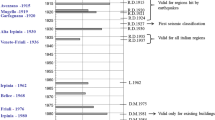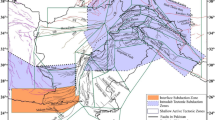Abstract
Studies oriented to restoration and conservation of historical monumental buildings have recourse to structural analysis as a way to investigate the genuine structural features of the construction, to better understand its present condition and actual causes of existing damage, to estimate its safety conditions and to determine necessary remedial measures. Based on this background, this paper discusses on the seismic vulnerability of masonry fortresses by means of an analysis methodology based on three different analytical procedures, according to an increased knowledge of the structure. As a relevant case study the Albornoz fortress, a 14th stone masonry construction located in central Italy, was selected. Initially, the strategy proposed to perform this task was aimed at testing and developing an expeditious and non-destructive procedure to evaluate both the seismic vulnerability and the main mechanical properties of the different masonry typologies. The macroscale structural behavior of the fortress was then evaluated through a nonlinear static analysis (pushover) and a more simple approach based on the kinematic theorems of the limit analysis. From this point of view, by comparing the capacity of the construction to withstand lateral loads with the expected demands resulting from seismic actions, these methods provided a highly effective means of verifying the safety of the masonry structure and its vulnerability to extensive damage and collapse.











Similar content being viewed by others
References
Acito M, Chesi C, Milani G, Torri S (2016) Collapse analysis of the clock and fortified towers of Finale Emilia, Italy, after the 2012 Emilia Romagna seismic sequence: lesson learned and reconstruction hypotheses. Constr Build Mater 115:193–213
Aedes Software. PCM (2014) Progettazione di costruzioni in muratura. http://www.aedes.it. Accessed 12 Nov 2017
Anzani A, Binda L, Carpinteri A, Invernizzi S, Lacidogna G (2010) A multilevel approach for the damage assessment of historic masonry towers. J Cult Herit 11:459–470
Asteris PG (2008) On the structural analysis and seismic protection of historical masonry structures. Open Constr Build Technol J 2:124–133
Asteris PG, Chronopoulos MP, Chrysostomou CZ, Varum H, Plevris V, Kyriakides N, Silva V (2014) Seismic vulnerability assessment of historical masonry structural systems. Eng Struct 62–63:118–134
Bartoli G, Betti M, Giordano S (2013) In situ static and dynamic investigations on the ‘‘Torre Grossa’’ masonry tower. Eng Struct 52:718–733
Bartoli G, Betti M, Vignoli A (2016) A numerical study on seismic risk assessment of historic masonry towers: a case study in San Gimignano. B Earthq Eng 14:1475–1518
Betti M, Orlando M, Vignoli A (2011) Static behaviour of an italian medieval castle: damage assessment by numerical modelling. Comput Struct 89:1956–1970
Betti M, Galano L, Vignoli A (2014) Comparative analysis on the seismic behaviour of unreinforced masonry buildings with flexible diaphragms. Eng Struct 61:195–208
Borri A, Castori G (2011) Damage and seismic vulnerability of the portal of Palazzo dei Priori. Int J Archit Herit 5:219–240
Borri A, Castori G, Grazini A (2009) Retrofitting of masonry building with reinforced masonry ring-beam. Constr Build Mater 23:1892–1901
Borri A, Corradi M, Castori G, De Maria A (2015) A method for the analysis and classification of historic masonry. Bull Earthq Eng 13:1–19
Cardoso R, Lopes M, Bento R (2005) Seismic evaluation of old masonry buildings. Part I: method description and application to a case study. Eng Struct 27:2024–2035
Casolo S, Sanjust CA (2009) Seismic analysis and strengthening design of a masonry monument: a “Maniace Castle” of Syracuse. Eng Struct 31:1447–1459
Casolo S, Milani G, Uva G, Alessandri C (2013) Comparative seismic vulnerability analysis on ten masonry towers in the coastal Po Valley in Italy. Eng Struct 49:465–490
Castellazzi G, D’Altri AM, De Miranda S, Ubertini F (2017) An innovative numerical modeling strategy for the structural analysis of historical monumental buildings. Eng Struct 132:229–248
Castellazzi G, D’altri AM, De Miranda S, Tralli A (2018) Numerical insights on the seismic behavior of a non-isolated historical masonry tower. Bull Earthq Eng 16:933–961
Castori G, Borri A, De Maria A, Corradi M, Sisti R (2017) Seismic vulnerability assessment of a monumental masonry building. Eng Struct 136:454–465
Cattari S, Degli Abbati S, Ferretti D, Lagomarsino S, Ottonelli D, Tralli A (2014) Damage assessment of fortresses after the 2012 Emilia earthquake (Italy). Bull Earthq Eng 12:2333–2365
Coïsson E, Ferretti D, Lenticchia E (2017) Analysis of damage mechanisms suffered by Italian fortified buildings hit by earthquakes in the last 40 years. Bull Earthq Eng 15:5139–5166
Corradi M, Osofero AI, Coventry K, Richardson AE, Udeaja C, Vo T (2014) Analysis and classification of historic construction within the north-east of England. In: Proceedings of the 16th international conference on structural faults and repair (SFR2014), London, UK
D’Ayala DF, Paganoni S (2011) Assessment and analysis of damage in L’Aquila historic city centre after 6th April 2009. Bull Earthq Eng 9:81–104
D’Ayala DF, Speranza E (2003) Definition of collapse mechanisms and seismic vulnerability of historic masonry buildings. Earthq Spectra 19:479–509
Decanini L, Gavarini C, Mollaioli F (1995) Proposta di definizione delle relazioni tra intensità macrosismica e parametri del moto del suolo. In: Proceedings of the 7th national conference on seismic engineering in Italy, Siena, Italy (in Italian)
Dolce M (1991) Schematizzazione e modellazione degli edifici in muratura soggetti ad azioni sismiche. L’Industria delle Costruzioni 25:44–57 (in Italian)
DPCM 2011 (2011) Assessment and mitigation of seismic risk of cultural heritage with reference to the Italian Building Code (NTC 2008). GU n. 47 (26.02.2011) (in Italian)
Faccioli E, Cauzzi C (2006) Macroseismic intensities for seismic scenarios estimated from instrumentally based correlations. In: Proceedings of the first european conference on earthquake engineering and seismology (1st ECEES), Geneva, Switzerland
Frumento S, Giovinazzi S, Lagomarsino S, Podestà S (2014) Seismic retrofitting of unreinforced masonry buildings in Italy. In: Proceedings of the NZ society of earthquake engineering conference (NZSEE), Napier, New Zealand
Giuffrè A (1999) Letture sulla meccanica delle murature storiche. Kappa, Bologna (in Italian)
ICOMOS 2005 (2005) Recommendations for the analysis, conservation and structural restoration of architectural heritage. International scientific committee for analysis and restoration of structures and architectural heritage (ISCARSAH), Barcelona
IMIT Circ. n. 617 (2009) Istruzioni per l’applicazione delle Nuove Norme Tecniche per le Costruzioni di cui al decreto ministeriale 14 gennaio 2008. Italian Ministry of Infrastructures and Transportation. G.U. no. 47 (26.02.2011) (in Italian)
Karantoni F, Bouckovalas G (1997) Description and analysis of building damage due to Pyrgos, Greece earthquake. Soil Dyn Earthq Eng 16:141–150
Lagomarsino S (2006) On the vulnerability assessment of monumental buildings. Bull Earthq Eng 4:445–463
Lagomarsino S (2015) Seismic assessment of rocking masonry structures. Bull Earthq Eng 13:97–128
Lagomarsino S, Cattari S (2015) PERPETUATE guidelines for seismic performance-based assessment of cultural heritage masonry structures. Bull Earthq Eng 13:13–47
Lagomarsino S, Magenes G (2009) Evaluation and reduction of the vulnerability of masonry buildings. In: Manfredi G, Dolce M (eds) State of the earthquake engineering research in Italy: the ReLUIS DPC 2005–2008 project. Doppiavoce, Napoli, pp 1–50
Lagomarsino S, Penna A, Galasco A, Cattari S (2013) TREMURI program: an equivalent frame model for the nonlinear seismic analysis of masonry buildings. Eng Struct 56:1787–1799
Locati M, Camassi R, Stucchi M (2011) DBMI11, la versione 2011 del Database Macrosismico Italiano, National Institute of Geophysics and Volcanology. http://emidius.mi.ingv.it/DBMI11. Accessed 15 Oct 2017
Mallardo V, Malvezzi R, Milani E, Milani G (2008) Seismic vulnerability of historical masonry buildings: a case study in Ferrara. Eng Struct 30:2223–2241
Margottini C, Molin D, Serva L (1992) Intensity versus ground motion: a new approach using Italian data. Eng Geol 33:45–58
Mastrodicasa S (1993) Dissesti statici delle strutture edilizie. Hoepli, Milano (in Italian)
Meschini A, Leoni G, Petrucci E, Sicuranza F, Zona A, Piattoni Q, Dezi L, Dall’Asta A (2015) An integrated survey experience for assessing the seismic vulnerability of Senigallia’s Fortress (Italy): documentation for conservation and FEM modeling. In: Proceedings of the 2015 digital heritage international congress (DH’15), Granada, Spain
NTC 2008 (2008). Nuove Norme Tecniche per le Costruzioni. Directive of the Prime Minister. GU n. 29 (04.02.2008) (in Italian)
Parisi F, Augenti N (2012) Uncertainty in seismic capacity of masonry buildings. Buildings 2:212–230
Penna A (2015) Seismic assessment of existing and strengthened stone-masonry buildings: critical issues and possible strategies. Bull Earthq Eng 13:1051–1071
Roca P, Molins C, Marí AR (2005) Strength capacity of masonry wall structures by the equivalent frame method. J Struct Eng Asce 131:1601–1610
Rossi M, Cattari S, Lagomarsino S (2015) Performance-based assessment of the Great Mosque of Algiers. Bull Earthq Eng 13:369–388
Rovero L, Fratini S (2013) The Medina of Chefchaouen (Morocco): a survey on morphological and mechanical features of the masonries. Constr Build Mater 47:465–479
Rovero L, Alecci V, Mechelli J, Tonietti U, De Stefano M (2016) Masonry walls with irregular texture of L’Aquila (Italy) seismic area: validation of a method for the evaluation of masonry quality. Mater Struct 49:2297–2314
Tomazevic M, Klemenc I, Lutman M (1999) Seismic behavior of masonry buildings. Lesson from the Bovec earthquake of April 12, 1998. In: Proceedings of the 8th Canadian conference of earthquake engineering, Vancouver, Canada
Acknowledgements
The financial support of the General Directorate for the Landscape, Fine Arts, Architecture, and Contemporary Art (DG PaBAAC)—Ministry of Cultural Heritage and Activities and Tourism (MiBACT) is gratefully acknowledge. The contribution of Prof. M. Cecconi and Mrs. A. Vecchietti is greatly acknowledged. The authors are also grateful to Mr. B. Gori and Mr. A. Giannantoni for their advices and support.
Author information
Authors and Affiliations
Corresponding author
Rights and permissions
About this article
Cite this article
Castori, G., Corradi, M., De Maria, A. et al. A numerical study on seismic damage of masonry fortresses. Bull Earthquake Eng 16, 4561–4580 (2018). https://doi.org/10.1007/s10518-018-0390-0
Received:
Accepted:
Published:
Issue Date:
DOI: https://doi.org/10.1007/s10518-018-0390-0




